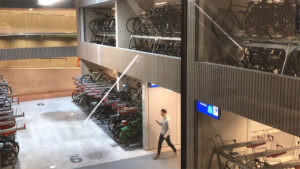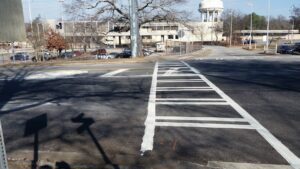 When the Netherlands began its transition to bike-based transportation, its train system developed some cunning plans.
When the Netherlands began its transition to bike-based transportation, its train system developed some cunning plans.
Car lots were replaced by bike parking, increasing their capacity 10-fold. A system of bike rental shops called OV-Fiets was developed around the stations. For the few who insisted on taking bikes with them on trips, a “Fietspass” is now offered. For about $10/day, you can take your bike on the train with you, during off-peak hours.
Folks who want their personal bike with them all the time can now buy folding bikes. They carry them onto the train like suitcases, then place them in the bike space. They unfold the things when they get off. It’s amazing to watch.
It all works well if you think of the bike the way the Dutch do, as a simple utilitarian device with little or no economic value. It’s the cat of mass transport. You may love your cat, and spend money on your cat, but there’s no market for your cat and if your cat runs away, you get another cat.
But the system is far from perfect, as I have learned on my visit here.
E-Bikes and Trains

But it does have economic value. There’s a bar that goes under the wheel you lock to secure it and keep a thief from moving it. The same locking mechanism controls a chain inside a cloth tube, which I can wind around any convenient metal bike stand.
Speaking of bike stands. Many don’t work as they once did. Tires have gotten wider and, as bikes have gotten more expensive, they just don’t provide security. A thick metal “staple” cemented into the ground on both ends, which my neighbors in Decatur, Georgia now offer, can work well. But there aren’t enough of them in the Netherlands to handle the demand.
Systems like OV-Fiets or the Swapfiets chain I use are designed to scale. You lock a bike at one end, take the train to your destination, and pick up a bike at the other end. Commuters use this system, which is one reason why the bike parking garages are often full.
But I have customized my Swapfiets with a round “grandma” saddle, to handle longer rides on 70-year-old legs. I must buy a Fietspass. It’s a system that doesn’t scale, as I learned during the Flower Parade. I also need to sit by the bike, lest it fall over. It’s uncomfortable.
E-Bikes and Train Stations

It seems the elevators and an escalator that get a bike over the train line to the platform are being replaced. I learned this just the other day. The work will take months. Riders at Maarssen have to get up around 30 feet (9 meters), then get back down, to reach the platform.
The e-bike won’t make it.
This means that for the duration of my trip, any train ride I make with the bike will require a 7-mile (11 km) ride into Utrecht for the train. The forecast for tomorrow, when I go to Maastricht, is for rain and temperatures around 10 c (high 40s F). I am not looking forward to it, nor to the need to get suitcases up-and-down for the trip home.

The point of all this is that, while car parks are expensive to build, you do need infrastructure even for a simple bike. And in the e-transport revolution, the bike is no longer so simple.









